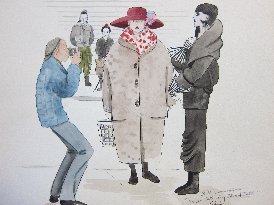 Carolina Meadows resident Bert Geiger has assembled over 260 fashion sketches from the 1970s to the 1990s. The drawings are by his late wife, Lorraine Dossett Geiger. Bert recently published the illustrations, with Lorraine’s commentary, in a book titled Fashions, Fads and Fantasies: Three decades of outrageous dressing. That’s a modest hint of what’s inside the covers.
Carolina Meadows resident Bert Geiger has assembled over 260 fashion sketches from the 1970s to the 1990s. The drawings are by his late wife, Lorraine Dossett Geiger. Bert recently published the illustrations, with Lorraine’s commentary, in a book titled Fashions, Fads and Fantasies: Three decades of outrageous dressing. That’s a modest hint of what’s inside the covers.
Bert and Lorraine, just out of high school, met in Long Island where they discovered a mutual love of fashion design. Lorraine had attended the New York School of Design and Parsons School of Design, and Bert attended fashion trade schools. After a nine year friendship they married in 1948. Bert formed his own custom millinery business that in time took him to Los Angeles and into ladies’ couturier fashions. In 1971 they moved to New York with their first of four children and Lorraine began her illustrations.
The “outrageous dressing” takes its cue from 1920s Paris where individual expression permeated the arts, including fashion. The flapper style became the symbol of the new woman, la garconne, free-thinking and rebellious. The cropped-hair, flat androgynous look said: Anything goes! Over the years, new rebels, free from fashion dictates, aimed a playful poke in the eye at both haute couture and mac-and-cheese traditionalists. Lorraine captured them all in her deft sketches from wherever the Geigers lived, worked, or traveled.
All the social issues of the time were expressed in the 1970s fashions. The Women’s Movement emphasized a more masculine look with pants suits and wide shoulders. Bras came off for a free unstructured look, then the Vietnam War called for a military style. Black politics influenced hairstyles with natural Afro and corn cob braids. Recession and unemployment led to street-urchin/bag-lady styles, shaggy torn clothes, clunky boots, battered hats and a tea kettle in hand.
 The New York disco scene pounced on daring for its conceit, with “look-at-me” clothes. A svelte transvestite wears a faded thrift store hat, pearls, harem pants under billowing skirt, high heels, and a Marabou boa. She’s upstaged by a dancer waving a fairy wand. She is totally nude, except for neck-to-toe transparent fabric, garter belt, boots, and ladylike white gloves.
The New York disco scene pounced on daring for its conceit, with “look-at-me” clothes. A svelte transvestite wears a faded thrift store hat, pearls, harem pants under billowing skirt, high heels, and a Marabou boa. She’s upstaged by a dancer waving a fairy wand. She is totally nude, except for neck-to-toe transparent fabric, garter belt, boots, and ladylike white gloves.
Conservatism in the 1980s created anti-fashion mischief with Punk-Grunge styles showing spiky dyed hair, deliberately ripped clothes, and leather-studded jackets. Freaked-out hair styles dominated, with heads shaved decoratively to allow braids or swathes of hair to stand straight up or poke to one side out of open-top hats. It was American DaDa.
In the early ‘90s Bert and Lorraine returned to Chapel Hill, where she captured both home-grown fashions and big-city styles, but with recycled ideas from the ‘20s,‘60s or ‘70s. Amusing scenes from Carrboro and Chapel Hill repeat Flower Children prettiness and Grunge returned with towering “fantasy” hats, all-black oversized tops and pants, klutzy boots, and more “scalpscaping.” Tattoos, face and body piercings, and fierce hair colors completed the look of creative chaos.
The “outrageous dressing” underground never saw that mocking the idea of “fashion style” is still just another style.
Bert has given a copy of the book to both the Fairways and Club Center libraries. It was Lorraine’s joy to create it and Bert’s joy to share it.
By Dorothy Mahan
